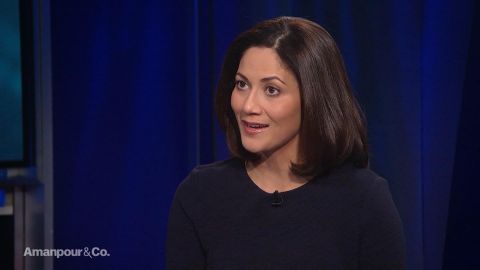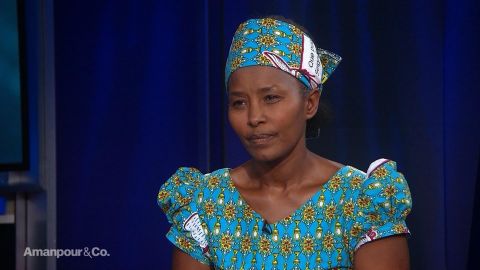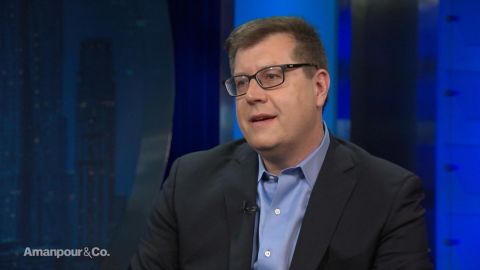Read Transcript EXPAND
CHRISTIANE AMANPOUR: Now, this week, we’ve also focused on U.S. prison reform and a few places, of course, are worse to live in, but one man argues there are even worse places to die in. Homer Venters was once the top doctor in Rikers Island. In New York City, it is one of the country’s most violent jails. His latest book, “Life and Death in Rikers Island” exposes the extreme health risk inmates and staff face and how brutality and abuse have become common place in an institution that’s bursting at the seams. When he sat down with our Alicia Menendez, he talked of dehumanization of mass incarceration.
ALICIA MENENDEZ: What was the basic work and responsibility of your job at Rikers?
DR. HOMER VENTERS, AUTHOR, “LIFE AND DEATH IN RIKERS ISLAND”: It changed. So when I started in 2008, I was a deputy medical director. So I oversaw some part of the medical service, the medical care people received. Then I became the medical director and ran all the medical care. And then I became the top doctor, which would have been the chief medical officer, essentially. And so overseeing all the mental health and medical and discharge planning work. And so as that responsibility grew, the scope grew, it really opened my eyes to, for instance, the harms of solitary confinement.
When I started working in 2008, I was focused a lot on physical injuries, and that certainly was important. But then it became clear to me with this larger frame, with the mental health service, that it wasn’t that the risk of injury was spread out evenly, right. It was spread unevenly. And often those disparities had to do with the race of the people that were hurt but also the places that they were held in the jail, like solitary confinement setting.
MENENDEZ: What are the most basic health risks of jails?
VENTERS: I would start with death. We have thousands of deaths in jails in prison in this country. We would measure, when I was in the city jail system, which death we would call “Jail attributable”. That is the death is directly related to something that happened in the jail. That doesn’t happen in other places and we don’t know how many of these thousands of deaths every year in jails and prisons are really preventable and jail attributable.
MENENDEZ: Tell me why doesn’t that happen in other places?
VENTERS: Well, I think that it is because these are paramilitary settings that we decided a long time ago that these health outcomes and the health care provided to people was under the authority of the security service. So if you look at who the doctors and nurses and social workers work for, most of these places they work for are sheriff or commissioner of corrections. So you have a local sheriff trying to spend as little money as they can. And when bad things happen, they are worried about lawsuits and so very little information gets out.
MENENDEZ: One of the things that was most surprising to me reading your book was just how difficult it was to deliver daily medications to people who needed them. This is because you couldn’t track where patients were.
VENTERS: Yes. And that basically continues, and it’s a systemic problem everywhere. It’s that as long as security staff have the ability to move people back and forth, to hide them places, sometimes for reasons of physical abuse or sexual abuse — but sometimes for neglect or sometimes just because they’re not sure what to do with somebody — that ability opens the door to some of the most profound abuse. Because if we don’t — we know more about what happens when you order a package on Amazon than we do about how human beings are shuttled from one cell to another, from one housing unit to another. And then with the power dynamic that exists in these places and the inhumane design of things like solitary confinement, the outcomes are really pre-determined. It’s brutality, physical sexual abuse, and neglect.
MENENDEZ: In your time there, were there specific people, were there specific cases that stood out to you?
VENTERS: In the vein of solitary confinement, this case of Jason, a young man who was in solitary confinement was thought of by the security service, and to some extent the health service, as somebody who was kind of faking things, that he wanted to get out of solitary, but they weren’t sure why or they thought he wanted to get for some sort of illegitimate reason.
There was a day where as often what happens in solitary confinement, many people were flooding their cells. People with mental illness at that time were in solitary. He was actually in a unit for people with mental illness who were in solitary, which should never exist. It’s insanity to even say that sentence. So he, like others, had raw sewage dripping, coming into his cell because people flood their toilets in a gambit to get out. Security staff came through and tossed this toxic soap balls into each cell. But what people were supposed to do was to take this little soap ball or two or three of them, put them into their toilet or their sink I guess and then take that soap water and use their hands or some garment to slop the sewage out of their cells.
And when he had these soap balls tossed in, he saw an opportunity, I would guess, we don’t know because he died but he swallowed them. And knowing that they were toxic, he told a passing health staffer and security staff I just swallowed these. And so the health staff said, oh, he’s at risk of dying. We have to get him out right away. What happened then is really a horrific story among horrific stories, which is that they didn’t let him out. They watched him, taunted him for hours overnight as he screamed as that soap corroded his esophagus, as he died.
At some point, which also you see in a couple of these stories, the lights went out and the video cameras mysteriously turned off. And when people came in in the morning and the lights came back on, he was dead. Having been taunted and ridiculed as he was dying, in full view of everybody else in this unit.
So that struck me because, you know, it didn’t matter what was in his heart about the source of his like psychological distress. We often fight about solitary confinement like how do we know if the patient is telling the truth or not. Are they — health staff will call, say the patient malingering or they’re using — they’re seeking what’s called “Secondary gain.”
Well, it doesn’t much matter because he died. And so when we did our large study of solitary confinement, we looked at physical self-harm because we wanted to cut through this idea of like we’re not lie detectors in medicine. The psychologist or the social worker doesn’t know the truth of what’s in somebody’s heart. But if somebody cuts themselves, if they hang themselves, if they swallow the soap ball, the fact that that behavior is associated with solitary should lead us to question what’s the reason we use this anywhere.
MENENDEZ: When we talk about solitary, we’re often talking about some of the most vulnerable populations in a jail or prison. How does that vulnerability intersect with the conversation around sexual assault in jails and prisons?
VENTERS: Well, the patients who are in solitary confinement are already unlikely to be believed by lots of people, including the health staff actually, because the security service has already labeled them as dangerous, as violent. They may, in fact, have lots of problems with aggression or violence. And so then they have lots of uses of force, right. They have lots of interactions, physical interactions. Many of the sexual abuse reports we would get in the jail system had to do with things that happened during a use of force.
So if somebody is being restrained by officers and then something is shoved into their rectum or they’re hit in the groin or there’s like a lot of comments about them sexually and then there’s some sort of sexual touching, all of that is very explicit power dynamic being used to humiliate, right. And so that is the more somebody interacts in this physical force domain, the more we see that there’s an opportunity for degradation that’s not just about physical or psychological traumatization but it’s about sexual abuse.
MENENDEZ: You also talk in the conversation about sexual abuse about how it is very easy to target certain individuals or how it’s easy to assess an individual’s vulnerability and take them on then as a target.
VENTERS: Given the need to survive and the kind of, you know, very — like the tribal nature of the who’s in power and who’s not in power and extortion, sexual abuse is a very common tool that’s used. And it’s very quickly assessed, you know, when people come into a new housing area probably before they hit the housing area, in the intake pens, as they’re moving through, maybe even before that, in the courts. The people that are not able to navigate the rules, the people that are viewed as weak physically, or who have problems processing new information or who don’t have allies are quickly preyed upon.
MENENDEZ: Right. You write about the stories of Brianna and Maria.
VENTERS: Yes. And I think those stories reveal both just how quickly and savagely weakness is assessed and used as a point of exploitation, physical and sexual exploitation. But then they also revealed to me at least how much of this abuse is ongoing. And so, you know, I think that based on what I know from the publically available information, these are women that came into the jails, were subject to repeated sexual abuse on multiple incarcerations, abuse that was not only violent but the abuse that led them to be then secondarily singled out for abuse by other inmates and other correctional officers.
Because other COs would recognize the vulnerability that they’re being abused brought to them. And so these strange scenarios where a correctional officer would tell one of them, what you’re doing isn’t right, it’s horrible, it’s dirty, it’s shameful when they’re the abused, they’re the victims, or survivors. And so that dynamic would play out with other inmates as well.
MENENDEZ: Talk to me about the concept of dual loyalty.
VENTERS: I think of all the things that I write about in the book, this is the problem that is least validated as a real problem, but to me is most concerning. You know, we have health staff all over this country that clear patients to go into solitary confinement. So completely unethical practice where the doctors, nurses, psychologists are part of deciding should you be punished or not. And it completely erodes the confidence, the relationship with our patients, not just in the jails.
I think you think about we have 12 million incarcerations a year, probably 11 million of them are in jail. So people going home, so what they’re going home with aside from the physical wounds and the psychological trauma, is that they’ve learned not to trust their health staff. And that’s a real –that’s a level of damage we haven’t even started to measure in the community for dual loyalty.
MENENDEZ: And yet you have sympathy for these correction officers.
VENTERS: Yes, I believe that these health risks are systems risks. That is to say, we’ve built and designed these jails and prisons to confer these risks to people. A lot of health risks are conferred to correctional officers themselves. In my time working at Rikers, we had a couple of correctional officers, relatively young, die of asthma attacks. Correctional officers have very good insurance. They should have good primary care access. But what is going on with their jobs? They have so many health problems. They work in incredibly toxic settings, and things like solitary confinement force them into a dehumanizing dynamic with people just as it forces the patient or the detainee into a dehumanizing situation.
MENENDEZ: We’ve talked a lot about what’s not working. What have you seen that is working?
VENTERS: So I’ll start with, in New York City, we’ve been more successful at lowering the rate of incarceration than any big city in the country —
MENENDEZ: Which you argue is the biggest thing one could do to address this challenge is less incarceration.
VENTERS: That’s right. But it’s a cautionary tale because we did that, and then the city more or less turned its back on a lot of the really core brutality problems that were happening for the people who go into Rikers. I think now in one of the areas of success is that we have built these better mental health units in the jails. Where instead of having somebody locked into a cell for 22 hours a day with not just worsening behaviors on their part but actually like a heightened risk of death, of self-harm, and risk to the staff that works with them, we built “Clinical Alternatives to Punitive Segregation.”
And those units had a whole raft of services throughout the day. So not just talk therapy or access to medications and psychiatrist, but movement therapy, art therapy, things that engage people. And when we published the data about those units, we started with these units are better, safer for everybody. Safer for staff, safer for patients, better outcomes from a health standpoint. But those units are incredibly expensive because of all those stuff I just mentioned. So probably what we should do is not put people with serious mental illness into jail period. And that is our bet because even those better, more therapeutic units, everything about them would be easier and cheaper if we did it in the community.
MENENDEZ: Prison reform has emerged as a uniquely bipartisan issue. Where do you see it going in the next 5 to 10 years?
VENTERS: Well, my hope is that you know, the coalition of people that buy into prison reform can come together to understand that the way we keep people, the way we undo mass incarceration is by building structures in the community that aren’t there today. If what we do is simply put a restriction in the courts to say like a lot of people aren’t going to go in and we restrict by charge or by, you know, some profile who can go in, we won’t have built community structures that are health structures, that are a huge part of this is supportive housing that doesn’t exist in many communities. If we don’t exist — create those community-based structures, then what we do is we just set people up to return to that same door a week later or two weeks later or four weeks later. And so I think the true test is can we really invest in communities that need access to mental health services and employment, because that’s the way we will really have a sustainable undoing of mass incarceration.
MENENDEZ: Thank you so much.
VENTERS: Thank you very much.
About This Episode EXPAND
Christiane Amanpour speaks with Denise Uwimana about living through the Rwandan genocide and Mishal Husain about women climbing the career ladder. Alicia Menendez speaks with Dr. Homer Venters about the health risks for inmates and staff at Rikers Island.
LEARN MORE


